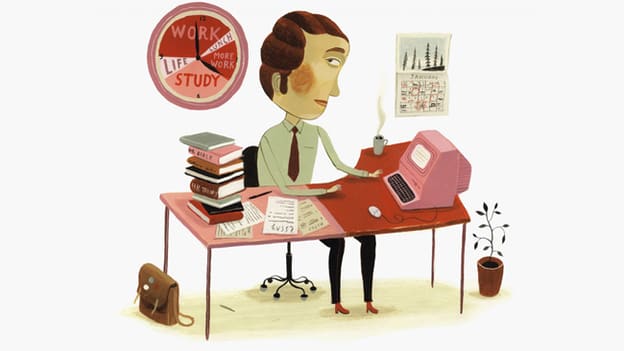India eagerly awaits a sixer

The two armies fought a fierce battle that lasted the entire day. At the end of it, the invaders had overcome the well-positioned defenders and killed their king. There are many causes attributed to this outcome but the (contested) one we shall choose is the relatively exhausted state of the defending army, because of the hard battle they had fought and won against another invader just a few days earlier. If the loss of England in 1066 is not enough to warn you against tiring your employees by extending their working hours, I don’t know whether the rest of my augments will. But let me try anyway.
My financially minded friends never tire of searching for quick (and sometimes dirty) ways to obtain more work with negligible cost increases. This was the thinking behind the old game of dropping in huge dollops of overtime in the hope of avoiding the fixed cost of additional manpower. It backfired badly when people found ways to benefit from the overtime without making a significant increment in output. Seasoned HR hands still laugh about the many times workmen resorted to round-robin absenteeism or goofed off during regular working hours to ensure they got overtime without overwork.
The current generation of get-profits-quick smart alecs are more focused on getting the same output at a significantly lower cost. Their first opportunity came with the Work From Home (WFH) imposed by COVID-19. Why not make an emergency measure permanent and save hugely on office space and overheads by using employee homes instead, on an effectively rent-free basis?1 Progressive organizations have thankfully swerved their corporate vehicles away from hitting the trust and performance damaging WFH cliff. Yet, now some of them are perilously close to falling into the ravine of the Longer Working Day (LWD). The argument that these longer workdays are made up through extended weekends or longer vacation-time is unconvincing, even if the additional hours worked are exactly compensated – which isn’t always the case. This is both because the substitutes (especially lapsable vacation days) find ways of vanishing due to exigencies of work or Parkinsonian home commitments and because the damage done by LWD cannot be undone at the end of the week, month or year. Starving for four days and gorging the next three would be a disastrous lifestyle choice. Work ''binging'', whether voluntary or forced, has scarcely less deleterious effects.
Long hours never bothered me
"Many of us have worked like that," growled a senior HR friend when I bemoaned the unhealthy trend that seemed to be starting. And he is right. Even today, most CXOs and several levels of upper and even middle management put in twelve-hour days regularly and much more when the occasion demands. Senior and staff people, however, have three major advantages that elude the larger part of the workforce.
Senior managers put in additional hours voluntarily. At least theoretically. The line of limousines leaving within half an hour after the CEO’s every evening throws some doubt on the voluntariness but those hours for displaying dedication are not usually work-filled.
More important, their output is not tracked closely: certainly not on an hour-to-hour or daily basis. This non-measurement lifts a huge amount of pressure and the consequential stress of additional hours from the person.
Lastly, the more senior the manager, the greater the freedom to determine the day’s schedule. Even when it is other-determined, the nature of most managerial activity permits self-pacing. For instance, it is very much up to a meeting participant (unless s/he is put on the spot for something) to decide how actively to participate or whether to indulge in mind-wandering to less stressful subjects. Attending to emails is another major and acceptable time-occupier that can be prioritized and speedily completed or dawdled over while distracted by other thoughts – wholesome or 'un'.
Despite these attenuators, there are some LWD liabilities that even the most self-directed senior executives cannot avoid. Taken together, they raise a red flag over double-digit hour days except during short emergency conditions.
The first of these handicaps affect women most and is, therefore, a body blow to any effort to bring about gender diversity at the levels that matter. The LWD is one of the most devious and devastating ways to discriminate against women climbing the upper reaches of the corporate pyramid.2 Even if women don’t self-unselect from trying for hour-hungry echelons, assessors will make the decision for them, especially if they have families and children.
Before male executives smile too smugly at this non-tariff barrier for women let me present a hurdle that’s blind to gender. Few would dispute the need for much above-average creativity for existing or aspiring occupants of the C-suite. Well, creativity and the LWD do not make good companions. "When you examine the lives of history’s most creative figures, [and] look closely at their daily lives, they only spent a few hours a day doing what we would recognize as their most important work… Their towering creative achievements result from modest 'working' hours… Everybody focuses on the most obvious, measurable forms of work …. This is how we’ve come to believe that world-class performance comes after 10,000 hours of practice. But that’s wrong. It comes after 10,000 hours of deliberate practice, 12,500 hours of deliberate rest, and 30,000 hours of sleep."3
There is one more set of damages caused by crazy work-hours, that again is not dependent on level or gender: truncated family time and inadequate exercise and sleep. The pride in getting the ''slogger'' tag becomes gossamer-light when destroyed marriages, maladjusted children, and physical as well as mental ailments are put in the other pan of the balance.
The plight of the measured many
Far greater costs await those who cannot adjust their own schedules and who cannot intersperse rest and recreation (even if unofficially) into long hours. For the majority of people in a modern organization, the output is closely tracked and shortfalls get converted into unpleasant consequences. Their LWDs are unremitting, monotonous, and damaging to body and mind.
There are reams of reliable and repeatedly replicated research that have reached near unanimity over decades about the ill effects of long working hours. Here are the findings of a recent meta-study. "Epidemiological studies have shown the negative effects of long working hours on the risks of cardiovascular diseases; chronic fatigue, stress, depressive state, anxiety, sleep quality, all-cause mortality, alcohol use and smoking; and self-perceived health, mental health status, hypertension… Similar results have been found for long working hours by other studies, for instance, myocardial infarction, poor physical health, and injuries, alcohol consumption, smoking, physical inactivity, and depression."4 Coming so soon after the upheavals and indirect health consequences of the COVID-19 crisis,1 any upward movement in the hours worked (whether on a daily or a weekly basis) can be extremely debilitating if not fatal.5
While much of the research deals with weekly hours, excessive daily hours cannot be compensated by extended weekends even if those did not fall prey to official or family demands on what appear to be windfall days, that appear too good to be squandered on rest and recovery. The human body and mind conform to the circadian rhythm – not a circaseptan (weekly) one. It is for this reason that experts find that: "[T]he shortening of daily workhours may be more effective for improving life-style than increasing the number of regular weekly holidays or paid holidays."6 Far more lethal can be the impact the extended work-shift has on safety. A recent study found that "… risk increased in an approximately exponential fashion with time on shift such that in the twelfth hour it was more than double that during the first eight hours."7
Some of my contemporaries would like to see young professionals today suffer the same harrowing work schedules they themselves had, decades back. They nostalgically talk about the unremitting twelve-hour days and six-day weeks we used to put in. Politeness prevents me from reminding them how eagerly they jumped off that ship as soon as a boat with saner working hours hove into view. Forcing today’s generation to go through what we did would be like insisting patients undergo operations without anesthesia simply because it didn’t exist in their parents’ time. Polonius-like pronouncements such as, "Young people can take it," ignore consistent findings8 that the young incur at least as much if not more (especially when they are newly establishing families which also demand peak attention) LWD-damage as everyone else.
We have viewed the LWD problem from the perspective of employees’ plight. However, quite apart from deteriorating safety levels (mentioned above), productivity,9 engagement, and management of medical costs/liabilities, which are all important for organizational performance, are also candidates for an inverse relationship with excessive work hours. If organizations remain myopic about their own long-term interests and put the well-being of their employees so far down in their priority lists, there is no option but to restrain them through regulations.
Legal limits
Even countries that intervene least in the contracts and interactions between employers and their people find it necessary to specify limits for the hours that can be worked in any day or week or both. Let me start, however, with the justifications used by countries that have few such restraints.
When I commenced my stint in France, offices, and factories were agog with the implications of the 35-hour week that had been launched by the coalition government of Lionel Jospin. "The idea of work sharing as an employment-creation policy is simple: if the production of goods and services in an economy is fixed, then a reduction in hours can redistribute the fixed amount of work across more people, increasing employment."10 This wasn’t so different from the solution (with certain caveats) that Keynes anticipated for the problem of technological unemployment."11 Unfortunately, this reasoning didn’t quite work out in practice and, whatever might have been its other consequences, the impact of the 35-hour week on unemployment remained uncertain. All the same, it would take a Quixotically courageous and ignorant economist (or bureaucrat), to project that additional working hours would generate employment.
Quite apart from employment generation, however, just as the Government regulates other facets of industrial safety, it owes it to the working population to prevent any steps that would massively impair employee health. And this it needs to do even if the people concerned have fallen for the lure of (elusive) longer weekends or vacations that accompany these work-extending measures. "Governments should clearly recognize the importance of maintaining the health of workers because the productivity of the workforce is what sustains the development and enhancement of society and the economy… If no maximum working hours or standard working hours have been established, the health of workers is threatened by the negative health effects of long working hours."4
When people talk airily about the 'freedom' to work twelve-hour days as long as there are (theoretically) longer weekends or vacations, they are perhaps unaware of the fierce battles that had to be fought to bring down the inhumane hours of work that accompanied the industrial revolution and down to the 19th and early 20th centuries. The most popular labor song in the US in the 1860s, '70s, and '80s was 'Eight Hours' and this is how it opened.
We mean to make things over, we are tired of toil for naught
With but bare enough to live on and ne'er an hour for thought.
We want to feel the sunshine and we want to smell the flowers
We are sure that God has willed it and we mean to have eight hours;
We're summoning our forces from the shipyard, shop, and mill.
Chorus:
Eight hours for work, eight hours for rest
Eight hours for what we will;
Eight hours for work, eight hours for rest
Eight hours for what we will.
These long and sometimes bloody battles culminated in "[t]he first international labor standard, the ILO Hours of Work (Industry) Convention, 1919 (No. 1), [that] enshrined… the eight-hour workday, into international law, alongside a 48-hour weekly limit on working time…."13 Do we really want to regress and surrender the territory gained over years of struggle? We shouldn’t forget that the greatest impact of such a retrograde step will be borne by the precariat consisting of contract and GIG workers who have little chance to avail of compensatory vacation days and are in the weakest position to protest.
Hitting a sixer
So much palaver just to defend the eight-hour day? Not exactly. Keynes wasn’t slipped into the column just to justify Jospin. His solution to a future where some people are unemployed (and hence unpaid) while those having jobs are forced to put in ridiculous hours of work, was to distribute equitably the work available after technological innovation had done its most (or worst). He concluded: "Three-hour shifts or a fifteen-hour week may put off the problem for a great while".11
Admittedly, this is an endpoint that’s far beyond us today. In the meantime, we can certainly look at countries where six-hour days have been rolled out with considerable success and satisfaction. One of these is Sweden, where an increasing number of companies are moving away (in the right direction) from the century-old eight-hour standard. And they seem all the better for it. Here’s the report from the CEO of one such enterprise: "The biggest response that I couldn’t foresee was the energy level I felt with my colleagues… They were happy leaving the office and happy coming back the next day. They didn’t feel drained or fatigued. That has also helped the workgroups to work better together now when we see less conflicts and arguments. People are happier."14
Happiness, though crucially important, is not the only likely benefit. Physical and mental ill-health, that suffer under LWD, obviously improve in the positive direction with the six-hour workday. Equally importantly, people are encouraged (even forced) to eliminate wasteful effort, meetings, web dawdling, and pointless time-fillers. Of especial interest to those undertaking intellectual and creative tasks should be the possibility of fitting the shortened workday around that part of the circadian cycle when the brain is at its active best. This would result in better problem-solving and higher innovation in the limited time available.15 Steve Glaveski sums it up well. "By cultivating a flow-friendly workplace and introducing a shorter workday, you’re setting the scene not only for higher productivity and better outcomes, but for more motivated and less-stressed employees, improved rates of employee acquisition and retention, and more time for all that fun stuff that goes on outside of office walls, otherwise known as life."16
So which CEO, in this cricket-loving country, will make history by being the first to lead an Indian company to hit daily working hours for a six? And what better way could there be to attract the best talent for that wonderful place to work?
Notes:
- Visty Banaji, 'Working from Home is NOT a piece of cake', People Matters, 25 January 2021.
- Sylvia Ann Hewlett, Executive Women and the Myth of Having It All, Harvard Business Review, April 2002.
- Alex Soojung-Kim Pang, Rest: Why You Get More Done When You Work Less, Basic Books, 2016.
- Kapo Wong, Alan H S Chan and S C Ngan, The Effect of Long Working Hours and Overtime on Occupational Health: A Meta-Analysis of Evidence from 1998 to 2018, International Journal of Environmental Research and Public Health, 13 June 2019.
- J Johnson and J Lipscomb, Long working hours, occupational health and the changing nature of work organization, American Journal of Industrial Medicine, Vol. 49, No. 11, 2006.
- Soichiro Maruyama and Kanehisa Morimoto, Effects of long workhours on life-style, stress and quality of life among intermediate Japanese managers, Scand J Work Environ Health, October 1996.
- S Folkard and P Tucker, Shift work, safety and productivity, Occupational Medicine, Vol. 53, No. 2, 2003.
- Sungjin Park, Hyungdon Kook, Hongdeok Seok, Jae Hyoung Lee, Daeun Lim, Dong-Hyuk Cho and Suk-Kyu Oh, The negative impact of long working hours on mental health in young Korean workers, PLOS ONE, 4 August 2020.
- L Golden, The effects of working time on productivity and firm performance: A research synthesis paper, Conditions of Work and Employment Series No. 33, International Labour Office, 2012.
- Marcello Estevão and Filipa Sá, The 35-hour workweek in France: Straightjacket or welfare improvement?, Economic Policy, July 2008.
- John Maynard Keynes, Economic possibilities for our grandchildren, Essays in Persuasion, Harcourt Brace, 1930.
- P S Foner, Eight Hours, American labor songs of the nineteenth century, University of Illinois Press, 1975.
- Jon Messenger, Working time and the future of work. ILO Future of Work research paper series, 2018.
- Adele Peters, Why Sweden Is Shifting To A 6-Hour Workday, Fast Company, 29 September 2015.
- Clément Fournier, Are Shorter Working Days The Secret To A Happier, Healthier And More Productive Life?, Youmatter, 25 September 2017.
- Steve Glaveski, The Case for the 6-Hour Workday, Harvard Business Review, 11 December 2018.















